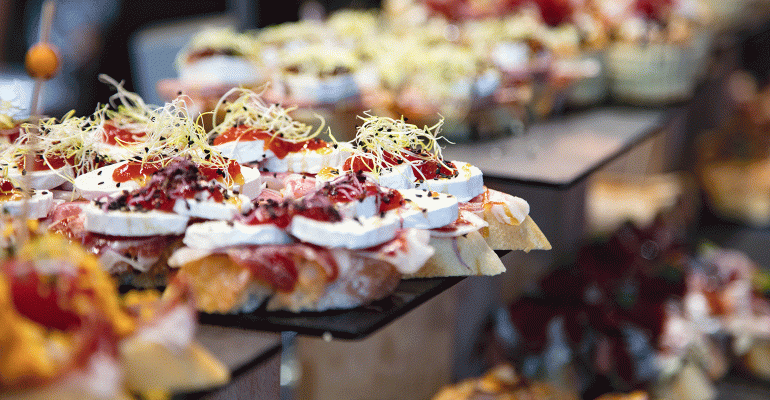Catering was the fastest growing channel in the restaurant space prior to the pandemic, outpacing overall industry growth by 50%. That momentum came to an abrupt halt when shutdowns went into effect and anxiety took hold.
Now, however, the catering business seems to be making quite the comeback – even exceeding pre-pandemic numbers in some instances. Last week, catered corporate bookings at ezCater were 184% higher than the company’s average weekly bookings in January 2022, for instance.
“Our business is fully recovered from the pandemic and stronger than ever before,” said Mike O’Hanlon, ezCater’s chief customer care and operations officer.
During BJ Restaurants Q3 call last week, President/CEO Greg Levin said his company’s catering business is up about 75% over 2021 and more than double 2019 levels.
“We expect the trend of more workers returning to the office and more in-person meetings to be a tailwind for catering in the near-term,” he said.
He’s not the only one with optimism here. Marco Panicali, co-director of operations at Jersey Mike’s, said the sandwich chain’s catering business is now up to 35% higher than pre-pandemic levels, and nearly 65% higher than 2020-2021 numbers.
“More than anything, people are back to being out and about. Our customers are gathering again,” Panicali said. “We are engaging with additional third-party delivery partners to offer our catering via delivery to more customers than ever. We expect the added convenience and availability to bolster sales and expose our catering to new customers.”
Cracker Barrel CEO Sandy Cochran expects her company’s catering business to grow by 25% in fiscal 2023 and top $100 million in sales.
“We see real growth opportunity throughout this category, both business-to-business and business-to-consumer,” she said during the company’s Q4 earnings call in September.
Chuy’s recently expanded its catering channel to 16 markets and its business is also exceeding expectations.
“We’ve blown away any numbers we’ve had in the past. We’re hitting all-time highs, close to double what we were in 2019,” CFO Jon Howie during the company’s Q2 earnings call in early August. “We’re close to about 3% of sales right now in catering. We think that can grow easily to 4%, to 6%, once we start promoting it and get it in all markets.”
As the channel makes a convincing comeback for some brands, adjustments have been made to meet changing consumer expectations. Such adjustments are likely expediting the channel’s recovery, as nearly half of all Americans remain in a remote or hybrid work model. In 2020, Jersey Mike’s added options aimed at smaller groups, for example, as well as offerings that are individually wrapped. Panicali said this relaunch has helped “catapult sales.” Panera also adjusted its catering approach for the new environment, adding options such as group ordering and “Panera Day at Work” for hybrid models. A Panera spokesperson said the business is “responding incredibly well” to these changes. ezCater has experienced higher demand for individually packaged items and an increase in last-minute orders, indicating unpredictable work schedules.
“Food for work is more complicated than ever. Many companies have adopted hybrid schedules, allowing employees flexibility around if and when they come into the workplace,” O’Hanlon said. “Fixed overhead food providers like in-building cafeterias simply can’t offer as much flexibility or keep their costs so closely in line with demand.”
Despite this complexity, the in-person workplace catering business tends to generate more frequency and higher average checks than other catering jobs, and therefore seems to be where companies are most intensely focused. BJ’s is testing a “more high touch catering experience” for corporate business, for instance, while Panicali anticipates Jersey Mike’s catering business to continue to grow as more people return to offices.
Catering overall is expected to continue on an upward trajectory and is, in fact, identified as one of the top three priority channels for operators in the next 12 months, according to Toast’s new Voice of the Restaurant Industry Survey. Operators are bullish on the channel for a reason. Catering can represent up to 20% of sales at restaurants, O’Hanlon said. It also typically comes with a higher check average and diversifies revenue streams, which has become even more critical since the pandemic.
“Catering orders are larger and more profitable than other off-premises orders. In fact, the average value of an ezCater order is over $350. Plus, catering orders can be made in off-peak hours, which can help combat labor shortages that many restaurants are facing,” O’Hanlon said. “This is a great channel to capture high-value buyers and also service high headcount events that can get a brand in front of dozens, or hundreds, of potential customers.”
Contact Alicia Kelso at [email protected]

